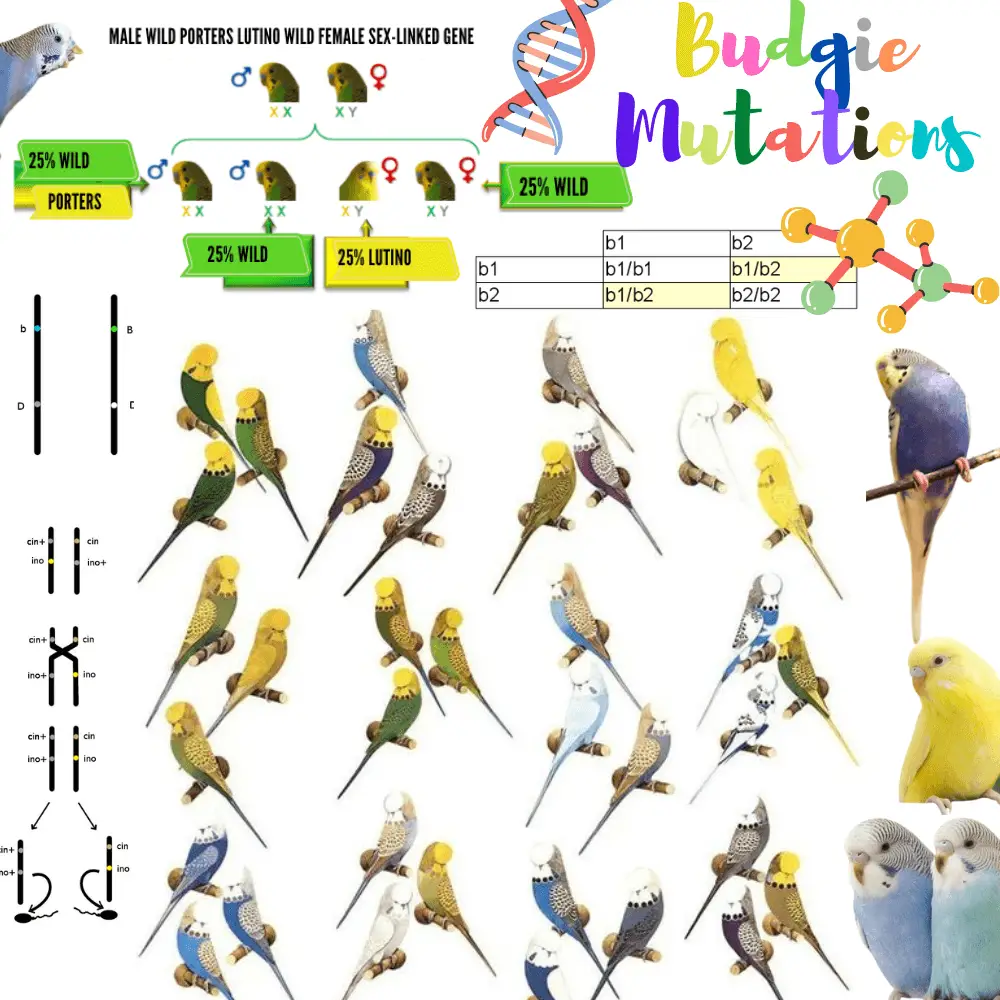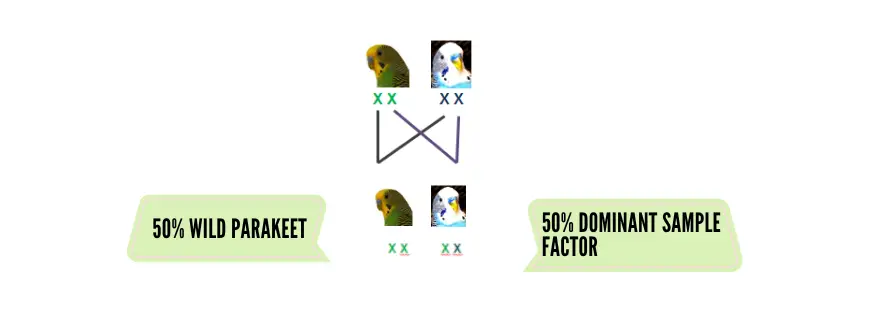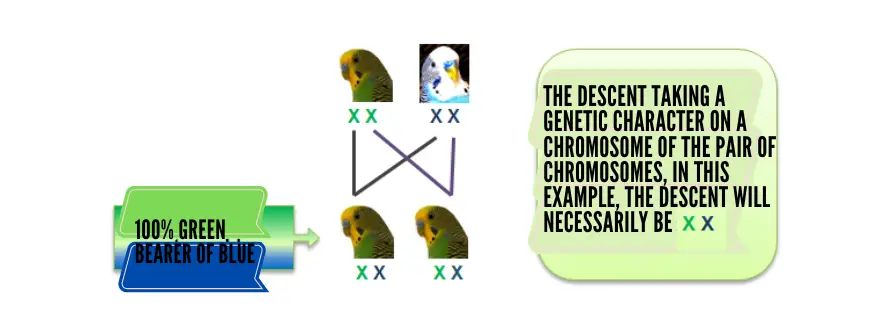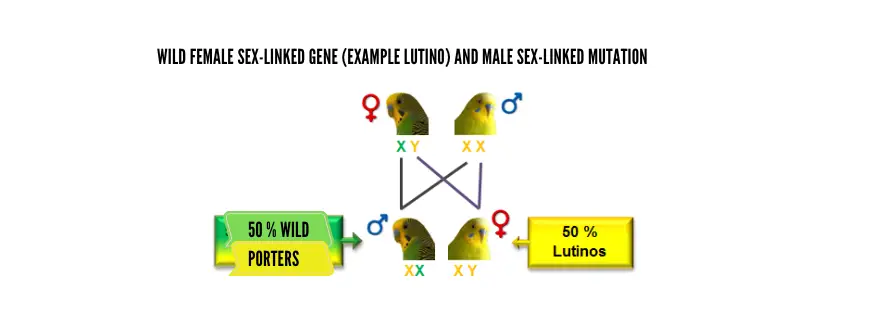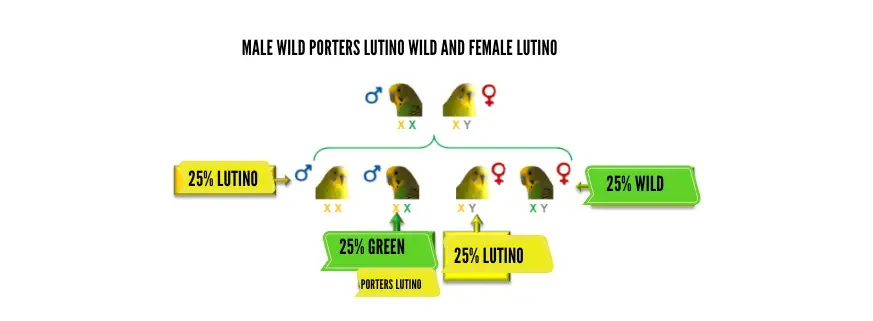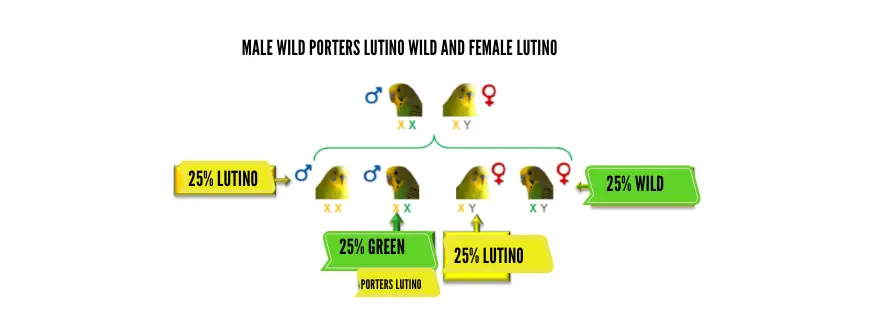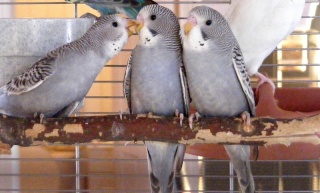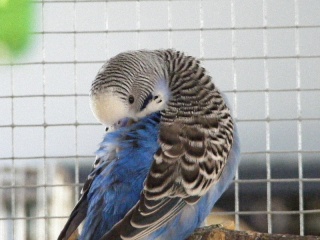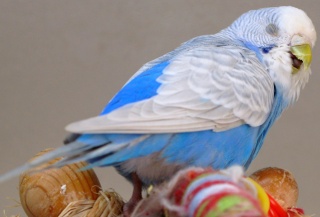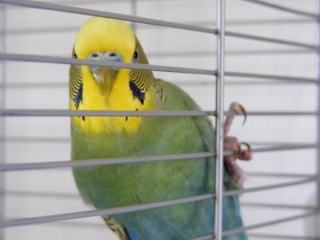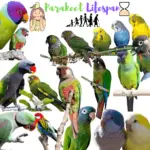The green mutation
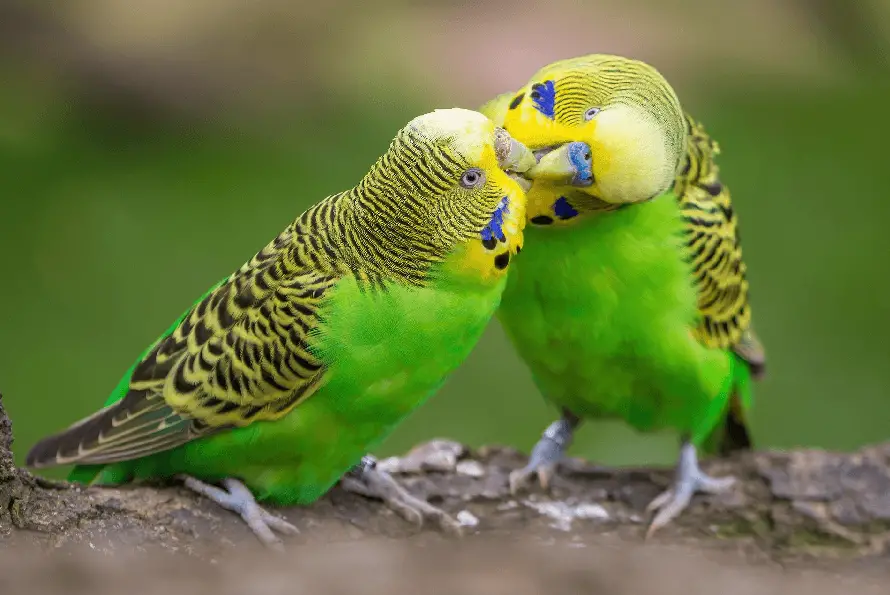
The green mutation is the color closest to the natural color of wavy parakeets in the wild world. This is why green mutation wavy parakeets are commonly referred to as “wild” mutation. There are 3 green mutations: Light green “wild” type, dark green, and olive green. It is the dark factor that will affect the color of the body of the budgie. If there is 0 dark factor = it gives a green (or light green, or “wild” type, bright color). If there is 1 dark factor it gives a dark green (green plus dark) and if there are 2 dark factors it gives an olive green (dull and deep color, olive green as the name suggests).
The blue mutation

The Blue mutation appeared in 1881 in Holland, it is a recessive mutation. This mutation causes a total suppression of carotenoids (yellow), which is why the parakeet appears all blue, with a white mask (face, wing feathers), and the undulations are not altered. The spots are black and the ear spots are blue. There are three kinds of mutation blue (just like green). The parakeet that has the mutation with 0 dark factors is sky blue. With 1 dark factor, it is cobalt (darker blue), and with 2 dark factors, it is blue purple (the purple parakeet will have purple ear spots, unlike a gray one where the ear spots are gray-blue). These last two kinds (cobalt and purple, appeared in Green 1921 in France.
The gray mutation
The grey mutation appeared in 1936 in Australia, it is a dominant mutation. This mutation also called “Australian gray” changes the color of the parakeet, which appears gray on a White base parakeet (blue), and khaki gray-green on a yellow base parakeet (green). Ear spots are gray-blue. The metrics change from the color blue (or green) to black color. If the parakeet is of a green base, it will give a gray-green (mustard), if the base is blue, it will be gray-blue on three possible tones: light gray for dark factor blue 0, smoky grey for dark factor 1 blue, and dark grey (anthracite) for dark factor 2.
The purple factor
It is a dominant heredity factor, which generates a wavy parakeet either mutated or non-carrier. There is no such thing as a purple wearer. For the color purple to be expressed, it is necessary that the wavy parakeet or blue, possesses a dark factor and a purple factor. It is therefore a Cobalt with a purple factor. On a budgie of the yellow base, the purple factor will not be visible, except for purple reflections at the level of the feathers of the cloaca.
On a wavy parakeet with a white base without this dark factor, we will speak of “purple blue”, which will have purple reflections distributed unevenly on the body.
Mutation Opaline
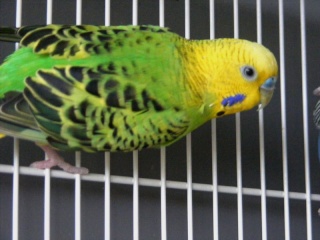
This mutation originated in Australia in 1932 and subsequently appeared spontaneously in Europe. “Opaline” is a mutation that is added to the basic color mutations (green, blue, gray, purple) and so it exists on these different colors. At the physical aspect, it takes a trained eye to see the opaline. The mutation is sex-related, so it is necessary to mate a male carrier with an opaline-mutated female.
It will be considered that the mask extends to the entire head and the characteristic ripples are less extensive. The opaline mutation causes a decrease in melanin in certain parts of the body. The mutation forms an absent V of ripples on the upper back after the neck. In addition, the black beads of the mask are well-defined and larger. Sometimes they can form a Beaded necklace.
Dilute mutations
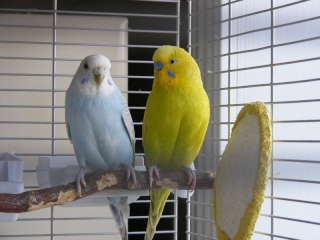
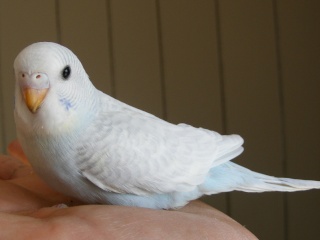
The “diluted” mutation appeared in 1870 in Belgium. It is represented by a greater degree of dissolution of the color of the plumage of the wavy parakeet because the presence of melanin is weaker. In addition, the wing/body contrast will be very marked compared to a diluted non-mutated bird. When the wavy parakeet is mutated and diluted, its body appears lighter, and its bright wings with a brighter color.
Light wing mutation
(clear wings)
Wavy parakeets carrying the “light wing” mutation will have yellow or white wings with feathers (long wing feathers) that appear light grey. Other writers (central retries, the top of the wings) are of a more normal color, that of the body. Ear spots are purple. Finally, the tone of the body color is barely lighter than if the parakeet were not a carrier of the mutation light wings, unlike wings that are well diluted, as well as the neck and head.
Grey wings Mutation
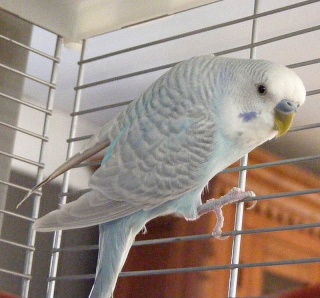
Wavy parakeets carrying the mutation “gray wings” have pearls and undulations of a smoky gray. The tone of the body is diluted by half by the mutation, so as to be uniform. Large diets and retries appear gray, even slightly bluish.
Cinnamon mutation

The mutation “cinnamon” or cinnamon appeared in England. It brings a fine plumage, drawn, with undulations with a glazed and shiny appearance. The spots will be brown cinnamon. In order not to confuse them with gray wings, observe the design of the wings and their undulation, the tone of the colors will be cinnamon brown. Another clue will be at the newborn, where are eye will be red and its eyelid pale, while at this age in the green specimen the eyelid is black. This mutation is related to sex.
Mutation Lutino

The Lutino mutation appeared in 1936 naturally in Australia, and in 1870 in a sought-after way in England. The Lutino parakeet is entirely yellow, with red eyes and no eye circle Yellow can be light, medium or dark (straw yellow, buttercup). There is a total disappearance of melanin, so ripples and spots do not appear, and spots Auricular are white. Its feathers and rectrices are lighter or even white. It is the absence of melanin that makes the parakeet yellow, blue does not appear, and only yellow subsists (for a green parakeet). Males, therefore, have pink wax. The mutation is related to sex.
Mutation Albino
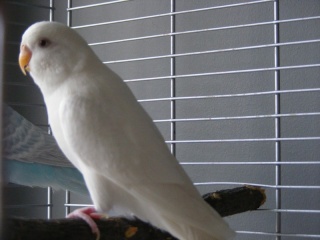
The albino mutation appeared in 1992 in England. It is also a gender-related mutation. The parakeet is all white, with red eyes, without eye circles, without spots, and spots white little fingers. It is also a complete disappearance of melanin, which makes the blue base parakeet appear entirely white.
Iace wings or lacewing mutation
The lacewing mutation is related to sex and appeared in 1940 in England. The mutation causes a partial withdrawal of melanin in the plumage. The lacewing changes the design and natural colors of the wing feathers and leaves a central core composed of diluted melanin to brown color. This gives the appearance of relief, slight curves, discontinuous and symmetrical, brown in color, like lace. The eyes are red and the wax of the masks is pink.
The spangles mutation
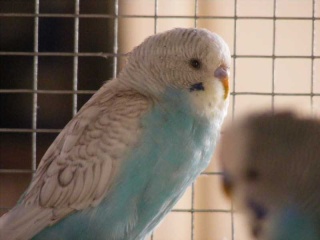
The “pearl” mutation appeared in Australia in 1972, and it is a dominant mutation. The wing marks are discolored, retaining only thin oxidized borders. The spots are also devoid of melanin in their center. The design of the feathers resembles a series of dark borders in the light center, of different tones. The two-factor pearl mutation gives on The parakeets of the green series of fully yellow parakeets (with black eyes) and on the blue series an entirely white parakeet (with black eyes).
The yellow-faces mutation
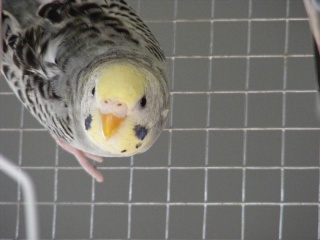
Yellow mask type I (MJI)
Yellow mask on face and secondary effects
Yellow mask type II (MJII)
Very bright and generalized yellow mask on the wings and on the body
The yellow mask mutation appeared in 1937 in England, it is a dominant mutation (semi-dominant for the MJI). This mutation brings the presence of a yellow mask, on any type of mutation of the parakeet, that is to say as much on a green parakeet (the mask will almost not be seen that the parakeet will already be mutated green and therefore yellow of the head) as on a blue parakeet, grey, etc. For the MJI, yellow is present on the face (mask) and feathers under the tail (secondary registers). For the MJII, the yellow is also generalized on the feathers (long wing feathers), on the wings, and on the upper body see more. There is also a third type of mask, called the “Australian Golden Mask“. There are few individuals in the Australian golden mask, a mask that is very bright, bright, and strong, and spread all over the body.
The Danish Pie mutation (recessive feet)
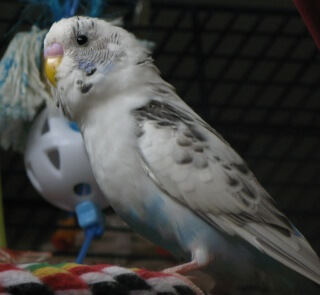
The Danish magpie mutation was born in 1932 in Denmark, it is a recessive mutation.
The Danish magpie mutation causes an absence of the eye circle and the eyes are black. The basic color is found on the lower half of the body, the remains of melanin being distributed irregularly on the back, wings, and neck which impacts the distribution of feather color and undulations. The wax is normal in the female but it is purplish pink in the male (pictured above). Finally, the spots are present from 1 to 6 instead of 6.
The Australian Pie mutation (dominant feet)
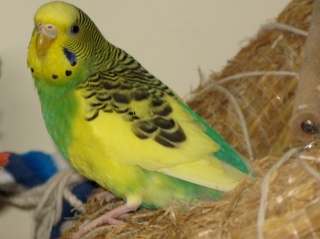
The Australian magpie mutation was born in 1929 in England, then in 1935 naturally in Australia. The mutation is characterized by a lack of local pigmentation, so the color is distributed per spot on the chest randomly. The Australian magpie mutation is characterized by the presence of a clear spot on the nape, the persistence of the white eye circle (unlike in Danish magpies), feathers and rectrices will be generally clear, and spots and purple ear spots will be retained. It is possible that the wavy parakeet wears the double factor of the Australian magpie mutation, i.e. 2 Australian magpie genes, therefore, the ripples almost disappear on the entire parakeet.
The Dutch Pie mutation and Clearflight and Clear body
Light penne parakeets are predominantly heredity: only the seven primary feathers and large tail feathers are clear and this is added to a light spot behind the neck. Thus a pale pennies wavy parakeet has feathers and clear retorts.
The Dutch magpie mutation is characterized by the color of the mask (which is the base color) that goes down quite low on the chest. Dutch magpies also have feathers and the bottom of the wings light, as well as the characteristic spot at the back of the head As with Australian magpies, the double factors Dutch magpies are almost entirely devoid of ripples.
The Ardulate Mutation (Slate)
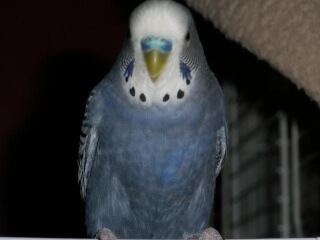
The slate mutation appeared in 1930. The slate mutation produces a dark gray bluish with heterogeneous colorations. The darkness of the slate varies slightly depending on the dark factor of the parakeet. The ear spots are blue-violet, and the dark factor is expressed on the slate.
The Cremino or Ivory mutation
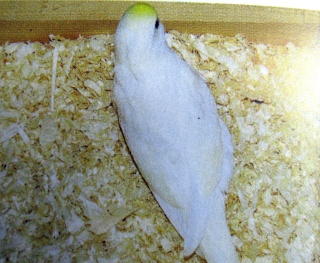
The Cremino or Ivory mutation is the association between the Albino mutation and the Yellow Mask. The mask and feathers (very slightly) are yellow, with a very white body, sometimes spotted with yellow in unexpected places.
The blackface mutation or black
The black-face mutation causes an excess of melanin, which gives the budgie a mask “loaded” with black ripples that go as far as wax, covering almost the entire face and more. what gives a dark appearance to the budgie.
The anthracite mutation
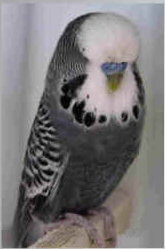
The Anthracite mutation appeared for the first time in 1998 in the breeding of Mr. Hans Jürgen Lenk, a breeder and judge in Germany. Anthracite has a black-gray body color, hence its name. The ripple pattern is black on a white background, and the wing and tail feathers are black. The mask is white and the spots are black, the cheek markings are blackish blue. The Eyes are black and show a white annular iris. The legs are grayish blue, the nails gray-black. There is a huge increase in black eumelanin.
German and English Fallow Mutation
With the Fallow mutation, the body color is very reduced. It becomes visibly yellow in green base budgies, white to very pale blue in blue-based parakeets, and this becomes faded white in gray-based parakeets. The spots of the wavy parakeet and the ripples appear brown in color. There are German fallows that have red eyes, with an eye circle, and English fallows that have red eyes without an eye circle.
Dark-eyes clear Mutation
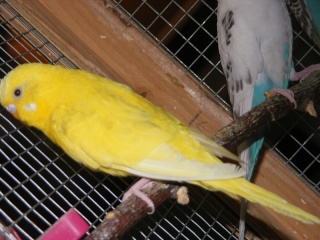
The “Light body with black eyes” (or light with dark eyes) is the assembly of two mutations, the mutation “light pennes” and the mutation “Danish magpie”. The combination of its two mutations causes the budgie to look completely yellow or white, depending on whether it is mutated green or blue. The “Light Body with Black Eyes” is different from a wavy Budgie ino or beaded double factor for his eye is completely black, as in the Danish Magpie.
The Crested or Crest(crested) mutation
The crested mutation appeared in 1945 in Japan, it is semi-dominant. There are three kinds of hoopoes: semicircular, circular, and toupee. These are the feathers on the head above the wax, and above the forehead, which form a crest, or a hoopoe of different shapes.
The Misty mutation
The Misty mutation is a co-dominant mutation that appeared in Belgium. It is represented by a dilution of 25% of the color of the body. That is, a light blue -0 dark factor) Misty would appear 25% more diluted than a normal blue. It exists in a single and double factor. In a simple factor on a green or blue, it can be confused with a normal parakeet (green or blue), But in a double factor, it appears all the clearer as it is perceivable. Ear spots appear bluer than a bird without a Misty mutation.
The Saddleback mutation

The Saddleback mutation appeared in 19775 in Australia, it is a recessive mutation. The mask extends to the entire head and the characteristic ripples and streaks are less extensive and replaced by color spots. The neck and mantle are diluted and grayish in color. Finally, the color of the basic wings (there remain the blackish spots and undulations) is either yellow (and not green) or white (not blue).
The Mottle mutation (Mottled)
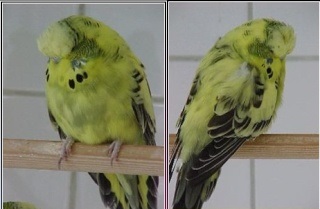
The “mottle” mutation first appeared in Adelaide, Australia in 1967 in the aviaries of the now-extinct Ethel Dobie. She obtained, in the blue series, her first ” mottle” by mating a purple male to a sky-blue opaline female. The peculiarity of these parakeets is that at the exit of the nest they have a normal phenotype, that is to say, nothing differs from other birds in the brood. Everything seems to change at the time of the first molt or a subsequent molt. Light spots begin to appear on the rump and back and eventually spread over the entire bird with the exception of feathers and rectrices which turn black. The parakeet is invaded by black suffusion (flecking).
The potential Coalface mutation or coal face
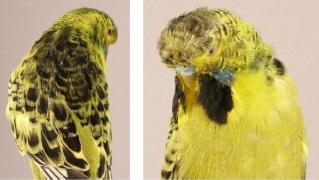
The Coalface mutation was discovered in 2007 in England by Mr. Darren and Mr. Cliff Jones. The budgie appears with no spots but large task substitutes, drooping along the neck. Then, the entire top of the head is loaded with black melanin, with ripples and charcoal spots, which extend over the collar and top of the back. This particular physical characteristic is not yet officially listed as a mutation, as there has not yet been sufficient reproduction to bind the gene and not enough studies to establish a distinct mutation and not a bad mating. Finally, this mutation looks a bit like blackface.
Mutation feather duster or chrysanthemum or feather plummet
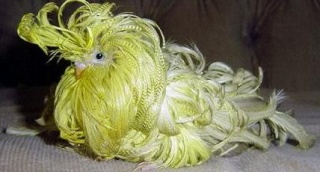
The feather duster mutation is a genetic aberration, it would be a recessive mutation. The mutation causes a very significant elongation of the feathers in the body and head, the Rectrices are shorter and the excess feathers are also shorter and equal in length. The open wing looks like a fan. The “Feather Duster” are very different from each other: Some have very long feathers, and others a little longer only. Unfortunately, this mutation is lethal, that is to say, that it causes death, since the lifespan of The parakeet “Feather Duster” is on average less than 1 year old (death occurs around 10 months, sometimes even as soon as you leave the nest). The continual growth of feathers without order prevents the parakeet to fly, feeding, and exhausting his body. This is why breeders do not seek to reproduce this mutation because the parakeet does not even live long enough to reproduce.
